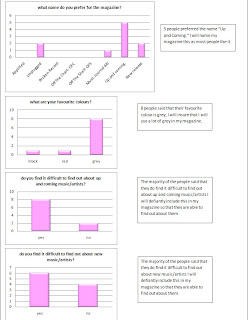



Depending who the feature artist is then the target audience will resolve around them, so the target audience will differ based on who is the feature artist. Basically if the feature artist is a Pop star, than their target audience will be fans who are interested in pop music. The choice of feature artist will be very important to attract the correct target audience. The type of language used is quite informal, there isn’t any need to have much academic quality, and most people will be able to read this article. Obviously because the article is written in English, it is aimed for people who are able to read English. This language appeals to the target audience as it is easily understood. “As all dead rock stars know” if this line was in another article it could be taken from a different aspect for example, if it was in a newspaper, then it would have a completely different concept, it would be seen that a rock star had passed away. Another example is “Fuck it, we’re gonna pretend like all this isn’t happening for a hot minute” as this was said by a rock artist is would be over looked at his fowl language however if the same expression would have been said by a politician in newspaper than the article would be seen as a bad representation for him/her, but because rock stars already have this image, so this doesn’t affect their status. I think that the tone that the magazine uses to address the reader is an informed intelligent fan, because although they speak with formal language they can be informal and relate to the target audience because but they also have are intelligently informed. They know the factual information about the band also. The text style of the text is plain, easily eligible, but is really small. All the other pages have similar fonts. The titles are a bigger font size than the font size of the article. The layout of the page is very organised as the text are assigned in columns meaning that the article is easily read and looks very presentable. One whole page is taken up with an image, with a quotation from the article. The next page is taken up by at least three quarters of the page with at least font size 72 which is another quotation from the article, this text is aligned to the centre of the page making it stand out more, also each line has a different font colour one line is a light green the other is a dark green. Then the interview begins with a brief opening paragraph, that doesn’t have any alignment and is approximately font size 16. Underneath this section the name of the person who has written this article is aligned to the right. The interview is then split into two columns that look as if it is in the middle of the page, the font size is rather small, and the article begins with a capital ‘A’ that is much bigger than the size of the other text. For the next two pages the article is split into three columns, one page has an image that takes up at least one quarter of the page
The tone that the magazine is using is that they are an informed intelligent fan, this is easily displayed because the text is formal, and if it was by a close friend or a member of in crowd then there will be some kind of slang words used. Through the image the artist is represented in a fun, quirky way. The images of him in the photo booth and the images it’s self. His fashion style is very Goth like. There aren’t any captions for the images. The images themselves are action shots, as if he was in the middle of doing something. There is also a shot of him performing at a concert.The only thing that is similar to the house style is the fact that the magazine title is at the bottom of the page. There is also some sort of similarity with the contents page and the article, because some of the words are in a coloured box.











.bmp)
.bmp)


